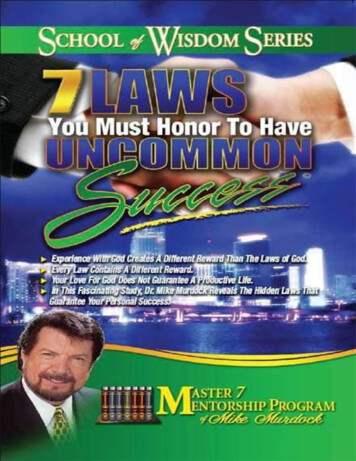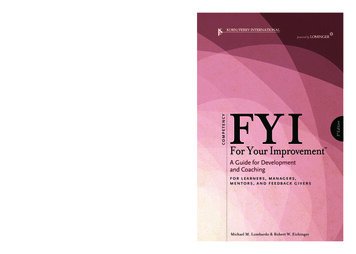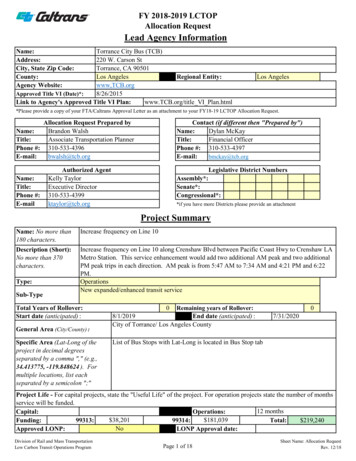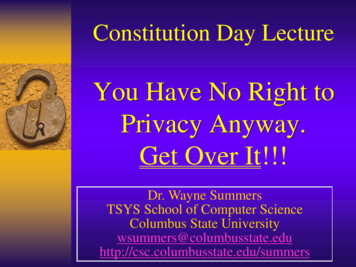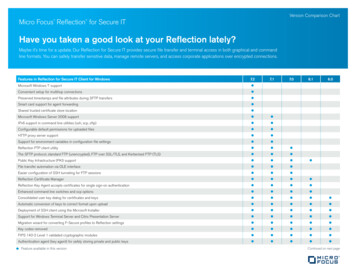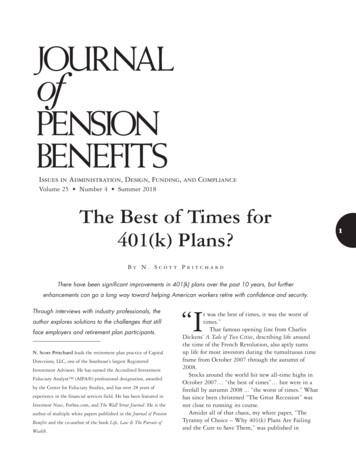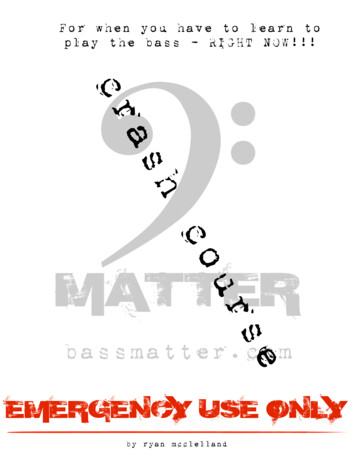
Transcription
For when you have to learn toplay the bass ! RIGHT NOW!!!hascrcoseurEMERGENCY USE ONLYby ryan mcclelland
Hi!Welcome! We!re not going to waste any time with why this book was made, whowe are or anything else.We will, however, cover who this book is for. If you!re any world famous bassplayer then we!re glad you got this book. Thank you, now get back to work! Keepmaking stuff to inspire the rest of us to learn! Newbies, those returning to thebass, people moving from guitar to bass in a band, or anyone that is underpressure to know what they are doing on the bass, and fast, pay attention! Thecollection of material of this book is, in our opinion, the basics to playing bassguitar for some event. Pay attention, burn through this as fast as you can, andyou!re on your way. You!ll develop style and technique as you go along.Two Rules to Start1- The bass player is the glue. There!s plenty of debateabout who keeps time and “leads” the band. Whatever,you keep it all together, play the root note and everyoneelse will pay attention to you to make sure they areplaying the right chord. If the bass is on the wrong note,the whole sound can derail easily. Your job is vital buteasy. Play the root note for the progression.2- The bass player isn!t noticed unless the bassist isnot playing, or playing the wrong notes. Get it? Ifyou!re crazy on the bass, then you!re no longer theglue, and eroding the foundation. If you are off, it!smuch better to quickly pause, listen and find yourplace again than scatter the wrong notes all over theplace. Skilled bass players know when and where theycan inject a tasty lick and not crash the whole band.You!ll get there. Be the glue.DON!TUNLESSYou are free to have different opinions on these points. When you get all pro andstuff you can make your own free book and teach the world how it really works.www.bassmatter.com
To play the bass you need.1- A bass. It doesn!t really matter which one or what kind. If you plug itin to an amp and it makes noise when you hit the strings you!re good.(you will form a different opinion later)2- Hands, all 10 fingers are recommended but not necessary. Withenough skill and practice you could end up using all 10 in somefashion down the road.3- Ears. One of the most overlooked parts of playing is listening toyourself. One ear will do, two is better.4- Patch cord (1/4” cable) This is the cable that plugs into the bassthen plugs into the amp. Something of decent length so you canstand and walk around a bit. 6 feet to 10 feet is a great place tostart.5- Amp. This is a variable place with many opinions. If you!relooking to play on stage you need 100 watts with a 12 inchspeaker. For practicing at home with no immediate ambitions toplay, a practice bass amp found at any music store will do.(Make sure you get a bass amp and not a guitar amp)6- Some way to tune your bass. This is most easily done with atuner. You can move on to tuning forks, harmonic tuning, andvariable instrument tuning later. Spend 20 and get a tuner.(Bass Tuning is EADG for a 4 string)7- You need to be able to count to 4. (1,2,3,4 OR One Two Three Four)You may not be able to acquire all ofthese things at once. Step one is kindof the most important one.Spend time learning your gear. What the knobs do on your bass and on theamp. How to tune. You may need to read instruction manuals, go to amusic store, and ask other players. We won!t cover it here due to time.www.bassmatter.com
How to Hold Your Bass(All instructions are for right handed players. Lefties, south!paws andsuch please reverse instructions)The Neck goes in left hand. Body of bass is under the righthand. The height of the bass should be comfortable. Somesuggest a high sitting position with the bass resting on yourchest, some over your abdomen, some below the waist. Much ofthis is preference for comfort AND for looks. However, positioncan effect technique, so mess with it until it feels right.Fingers(Any Questions?)Plucking Hand(The one bythe uryouryourthumbpointermiddlering finger(Pollex)(Index)(Middle)(Annularis)We will refer to the fingers often for the charts to come. Please refer backto this for reminders of which finger is which when necessary.www.bassmatter.com
PlayingOkay, you!re tuned up, plugged in, have figured out the knobson your bass and amp by experimenting and readinginstruction manuals right? Good.We!re going to start with the right hand. Leaving your thumbon the pick-up, use the i finger on your right hand to “pluck”the big fat string closest to your face. (The E String, or B stringon 5 or 6 string basses) You don!t want to pull “out” from thebass but pull up towards your chin. Once this motion becomescomfortable, add the m finger and switch between the two.What a mess!! Right? The craziest sounds are coming out of yourbass right now. You!re only plucking one string but the whole thingis vibrating, the other strings are making sounds and “resonating”with the big E string you!re plucking. Yup, this is where the lefthand comes into play. With your left hand, lay them across all thestrings between plucks to “mute” or “dampen” the strings. Repeatuntil you only hear the E string for each pluck.Good. Now that you!ve got that down, using your right hand alternating from the i to them fingers plucking the E twice, then the next string which is A then the next which D thenthe most skinny one closest to the ground which is the G string. Continue to work on thatmotion so your right hand gets used to moving up and down. Start from the top and godown, then start in the middle and go up one, then down two or whatever. Get the hint sofar? You!re moving up and down the strings plucking all while keeping it under control.“This sucks. I want to learn to play like Victor Wooten. Can!t I just start there? Fine, I!llsettle for some Primus? What? 12 bar blues? Who cares about blues?” Every bassplayer that wants to be a bass player knows 12 bar blues and that!s where many started.It!s a 1-4-5 progression, real simple over 12 measures. Make sense? No? Exactly.www.bassmatter.com
Learning NotesStart Here“Who cares about learning notes? Thisisn!t important. I don!t want to learn toread music, I just want to play.” Okaythen, play something.that wasbeautiful. Now, why learn where thenotes are on your bass? This is the mostbasic form of communication for bandmembers. Guitar players learn chords.This doesn!t mean they know how to readmusic either. “All right, we!re going to playC, F, G, four bars each and repeat.” Whatdoes this mean to you? Well, for some it!s1-4-5, others it!s the notation and it!s 12measures either way. This kind ofverbiage and communication is so normalthat if you don!t understand it you mayappear as though you don!t know whatyou!re doing. (Honestly you don!t.)On the right is a chart of the fretboard fora 4 string bass. The first five frets containevery note. We recommend memorizingthe first five frets of notes so you can playthe notes on command, then grow fromthere. Everything above the fifth fret issimply a duplication and perhaps higherpitched version of what!s in the first five.End HereRoot is all you need to start. Playing one note at a time and one note only makesyou a bass player. Playing in time and in rhythm makes you a good bass player.Being able to play additional notes and texture makes you a great bass player.www.bassmatter.com
#ScalesScale DegreeWhich Finger in Red1-2-3“Why learn scales? I just finished learning the notes and know root. I can play bass now.” Yes, you canin a garage band or to your favorite tunes on your iPod. Scales are the fist step to knowing andunderstanding how to create bass lines, identify what another bass line is and how to duplicate it. Asyou follow the scales, you will always go up (low to high) then back down (high to low). You will only usethree fingers for the patterns, 1, 2, and 3 and in that order going up and 3, 2 and 1 going down. Resistthe temptation to use the 4th finger. It serves a purpose, but not here. Not yet.kjsdfThe numbers in the scale chart are called “Scale Degrees”. Start paying attention to thesenumbers and get familiar with going from one number to another. This is a very common formof communication within bands. If someone says 1-4-5 in major, you know where to go!!www.bassmatter.com
Basic TheoryOkay, now you have the notes memorized, have some scales down, and have practiced the scaledegrees right? You know how to start on the 5 then go to 1 then to 3. If you!re in the key of C that wouldbe what? G, C, E - right? GOOD JOB!! Moving forward. The following chart is a small collection ofthings you!ll see on sheet music. Just as important are the words and what they mean when they areyelled out to you. “Play whole notes then eighth notes.” This may make some sense now, or none at all,but review and memorize the details below.kjsdfOften times different ways of learning to play a song will still incorporate musictheory terminology. Tablature, chords, private lessons, by ear, and so on.Understanding what these details are even if you don!t have “sheet music” isimportant for communication and figuring things out.www.bassmatter.com
Key SignaturesIn the world of music, there are sharps and flats. What are they? If something is “Sharped”then it goes up one HALF step or ONE fret “higher” (toward the body of the bass). If somethingis flatted you move down one HALF step or ONE fret “lower” (toward the tuners, moving awayfrom the body of the bass). One of the great tricks about bass guitar is when someone saysplay in the Key of E. All you need to know is the E Major Scale which you should if you knowwhere E is on the fret board and then play the Major Scale finger patterns. Because you knowthe finger pattern for ALL MAJOR scales then you are correctly playing the 4 sharps in the Keyof E correctly, which are F, C, G, D. Very cool huh? You!re a master!!!SHORTCWhen you see sheet music you can quickly find the key. If it!s Flats go to the second tolast Flat and that!s the key. This is always true except for the key of F. If you only seeone flat, it!s F. Tough to remember. For sharps, raise the last Sharp a half step andthats the key. You!ll have to learn which notes are on what space and what line which iscovered back on the basic theory page, but you already know all the notes right? )UTwwUnderstanding key signatures is something that will come with practice and time.By knowing the patterns first and the notes of the fret board you can begin to figureout which key has so many sharps and flats. The chart above is a very powerfultool and important to know so you can correctly improvise and create bass-linesfor songs. Also have a good understanding of what set of key signature rulesyou!re dealing with when you choose to solo and adjust an existing bass line.w.bassmatter.com
The CircleOf fifths.or fourths, depending which way you read. This goes hand in hand with the keysignatures chart you just learned. You!ll see that this circle goes in perfect order for fifths offourths in accordance to the key signatures, and defines the order of sharps and flats, andwhy. This doesn!t really do anything to help you play the bass in the near term, but is goodknowledge to have. If you begin to chat about the circle of fifths you sound smart, impressthose also jumping into theory, and it may actually help you down the road.FourthsFifthsCounterClockwiseThe Circle is one of the most popular charts to begin working with for music theory, andis considered by most music programs an element of basic musicianship. We agree.Learn this circle, understand how it arranges with key signatures, and how it onlyworks in fourths and fifths to correlate with sharps and flats. It!s very cool and anexciting element to music once it “clicks” in your mind.www.bassmatter.com
Counting“Counting? Really?” Yes! I promisethis isn!t an insult. You!d be surprisedat how much brain matter isstimulated by counting and executingyour fingers to be in sync.BPM Beats Per MinuteLets start at 60 BPM. The magicalthing about this is the question “howmany seconds are in a minute?”.Yup, this works out great. So, look atan egg timer, and old watch or ametronome if you have one.Playing one note per second in 4/4time would be quarter notes. Twonotes per second would be eighthnotes, four per second would besixteenth notes.1234QQQQ12andQRand3QR4andQRandQRQTTT QTTT QTTT QTTTHow to count these out loud?Quarter notes are the best place tostart. Always count 1-2-3-4. Now wewill break it up. 1-2-3-4 quarternotes counting. 1 and 2 and 3 and 4and would be eighth notes. 1 E AndA - 2 E And A - 3 E And A - 4 E And Awould be 16th notes.“You can’t hold nogroove if you ain’tgot no pocket.”! JD Blair (Adrummer for Vic)You!re a bass player. You!re the glueremember? You!re holding everythingtogether. Grooving with the drummer and/orpercussion is essential. As a rhythm sectionplayer, you are helping to keep the rhythm.If you can recall every scale, every note,every piece of theory, but can!t play intime.you!ll have a hard time making thecut. Learning the charts above applies to allways of playing. Knowing how these notessound in regards to pace and quantity isimportant in any setting.Learn the notes, learn the verbiage and be able to communicate to band members.When someone calls out “the verse is in eighth notes” you!ll know what!s going on!www.bassmatter.com
Reading Music This is a very important skill andoften times the last thing on yourmind when you start playing. Nowit!s time to practice a little bit. Thinkof this as a new language. You!ll getbetter at this with time and practice.Take it in small doses and work upfrom there.LBy now you should know the keysignatures. (This tells you whatthings are automatically sharp orflat in sheet music.) Accidentals arewhen something goes against thekey signature and shows up in themusic to make that specific notesharp or flat, just that one time.QQ
bass, people moving from guitar to bass in a band, or anyone that is under pressure to know what they are doing on the bass, and fast, pay attention! The

